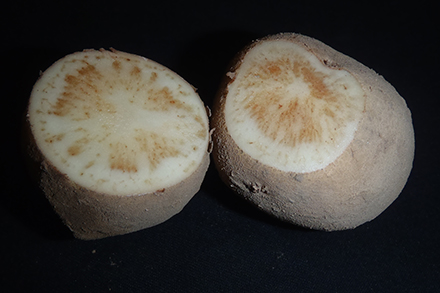
Researchers Try to Pinpoint a Moving Target
Insect that Transmits Potato Pathogen Plays Hide-and-Seek
Zebra chip is a disease of potatoes. It won’t hurt humans who eat it, but its bitter taste – and the fact that it kills host plants – makes it an economic nightmare for potato farmers.
Scientists understand the disease fairly well, and know that the pathogen that causes zebra chip is spread to plants by the sap-sucking potato psyllid. Potato psyllids resemble small cicadas. They are small, black insects with white stripes on their heads and mid-section and straw-like mouthparts that they insert into the plant to drink its sap.
While the pathogen can alter the insect behavior slightly, its biggest impact comes from its transmission to host plants. After a psyllid feeds on a plant that is affected by the disease, the pathogen is passed to the potato through the psyllid’s saliva during the feeding process. It doesn’t take long for an infected potato plant to deteriorate and die.
"Growers use insecticide applications to reduce populations of the potato psyllids," said Rodney Cooper, research leader at the Agricultural Research Service’s (ARS) Temperate Tree Fruit and Vegetable Research unit (TTFVRU) in Wapato, WA. "The use of insecticides is challenging because potato psyllids enter potato fields from weedy host plants. It’s difficult to predict when potato psyllids will arrive in potato fields and whether they carry the zebra chip pathogen."
Cooper is part of a team of ARS researchers that is working to solve the problem of discovering where the psyllid hides before attacking potato fields.
"This project uses molecular gut content analysis to identify the plants that psyllids previously fed upon," Cooper explained. "We use this method to identify the insects’ dietary histories, how they moved around the landscape before they were captured, and plant species from which they acquired the zebra chip pathogen."
Not all potato psyllids carry the pathogen; the problem is finding the infected pests so that farmers can treat their crops effectively. There is currently no cure, so stopping the spread is the only way to save potato crops.
 Potato infected with zebra chip. (Photo by Kylie Swisher Grimm, ARS)
Potato infected with zebra chip. (Photo by Kylie Swisher Grimm, ARS)
Kylie Swisher Grimm, plant pathologist with TTFVRU, recently developed improved methods to screen large numbers of potato psyllids captured throughout Washington State for the zebra chip pathogen so that growers can make informed management decisions based upon the presence or absence of the pathogen.
"Well-timed [application of] insecticides is the key," Swisher Grimm said. "A grower wants to minimize the cost associated with applying insecticides, but also doesn’t want to suffer yield and quality losses at the end of the season."
Swisher Grimm said that psyllids are captured and tested weekly so that farmers can have the latest information on the whereabouts of zebra chip infestation.
Collecting sample psyllids isn’t difficult because researchers know they tend to live in the weedy areas around potato fields. There are, however, many challenges to overcome, including the discovery of new pathogen variants, other insect carriers, and that the locations of the zebra chip pathogen change from year to year.
Other zebra chip intervention strategies include finding and breeding disease-resistant potato lines and finding natural predators of potato psyllids to control the insects prior to their arrival in potato fields.
"In the nearly two decades of research, in collaboration with university entomologists and pathologists, we have made significant advances in our understanding of the disease, and this information is routinely provided to growers for incorporation into their integrated pest management programs," Swisher Grimm said.
The ARS research into zebra chip can also be applied to other crops.
"Potato psyllid and zebra chip have become a model-system for potato vectors and bacterial plant pathogens," Cooper said. "For example, we are now using many of the methods we developed to learn more about the ecology and management of beet leafhopper, a vector of a pathogen that causes potato purple top." – by Scott Elliott, ARS Office of Communications
